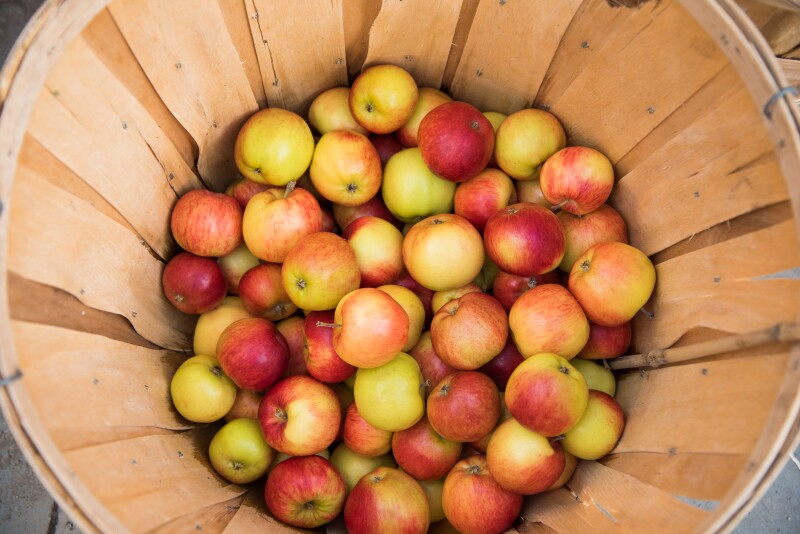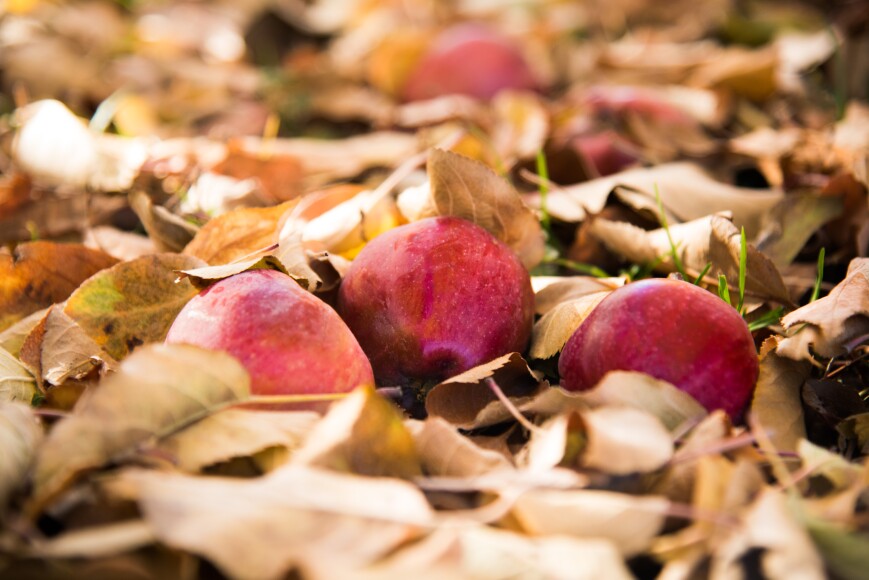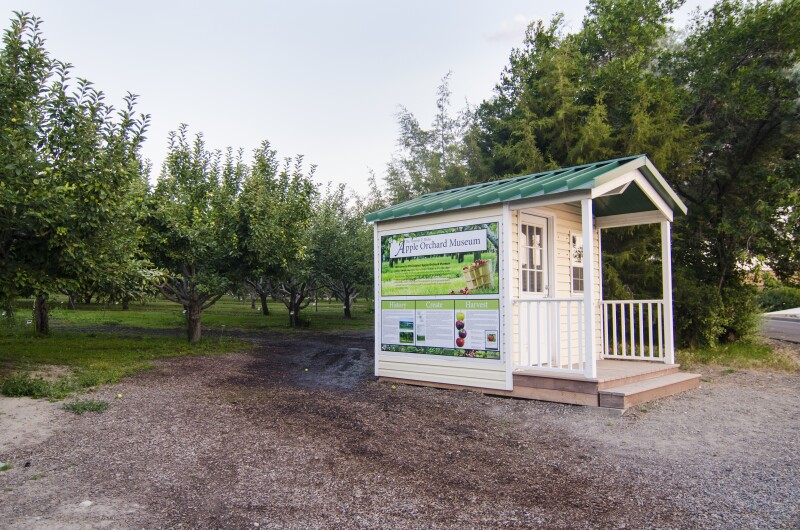Some activities from the past included bobbing for apples, creating leaf prints on paper, and scavenger hunts. Everyone enjoyed the warm weather, the tasty popcorn, and cotton candy!
The Orchard is located behind the Ricks Building, open Monday through Saturday from 8:00am-8:00pm.
Weigh and pay at the Apple Shed, located at the North Western corner of the Orchard.
Please don’t pick apples off the ground, they have been sprayed
Welcome to BYU-Idaho’s Apple Orchard Museum

We have over 150 different varieties of fruit trees in our Orchard. Some are good for canning, some are good for drying, and some are great for eating straight off the tree. We hope you can find a tasty favorite in our Orchard!
The orchard was planted by the Horticulture Department in 1980 under the direction of Dr. Kim Black and continues to be maintained by faculty and students. The orchard museum contains a large, diverse, collection of trees with rare genetics and unusual characteristics, some of which date back to the 1600’s. Every Season new and exciting changes occur to the orchard. Discover the changes for yourself as you explore this unique collection of historical trees.
History of the Apple


Local History
Many of the apple trees died except those that had Antinovka rootstock, a hardy, Russian rootstock. Immediately after that winter Dr. Black replanted the orchards with rootstocks from Russia and Ukraine to ensure the orchard could withstand the winters in Rexburg.
Overall this collection of 160 fruit trees is unique in the United States, especially in the Inter-mountain States where it is the only one of its kind. In the quiet reverie of this well cultivated history, the orchard continues to be an outdoor learning center where horticulture techniques are taught and practiced.


Apple Facts
Create Fruit Trees

Fruit trees are wonderful additions to a landscape and can be grown in rows like a traditional orchard or in restricted forms like an espalier garden. Some of the most glorious structures in a garden are the free standing fences or screens created by espaliered fruit trees with their plump, ripe fruit visible in attractive forms.
Restricted Tree Forms
Growing fruit trees in a restricted form is a time-honored gardening practice dating back thousands of years from the gardens of pharaohs in Egypt to great monastic gardens and castles carefully trained by monks. Restricted tree forms gained widespread popularity in England and France in the 1600s appearing in humble villages as well as the walls of the Palace of Versailles. In colonial America espaliered fruit trees were grown by George Washington at Mount Vernon and Thomas Jefferson in Monticello. Restricted tree forms are preserved and enjoyed as beautiful art forms in the home gardens and in grand gardens around the world.
There are several choices when creating a restricted form fruit tree:
Espalier: A tree is trained to grow against a wall or independently in a two dimensional shape with multiple tiers. A tier is a level at which two horizontal branches are allowed to grow.
Cordon: Training fruit to grow along a single trunk with no side branches, many times planted at 45° to enhance fruit production. A Belgium fence is an example of multiple cordons being grown together to form a living fence.
Fan shape: A single trunk is trained with branches radiating out in a two dimensional fan pattern. These trees can be grown against a wall or trellis.
Yield of Apples & Pears
Pruning fruit trees in restricted forms produces superior fruit because they receive optimal sun and air circulation, which helps control pest problems. Furthermore, their compact form can be grown in protected areas, such as along walls where they are kept from frosts and severe weather. They bring versatility and add ornamental beauty to small and large spaces and also produce flowers and fruits more abundantly per square foot than a traditional tree. Pears and apples can be grown in all three traditional shapes, but plants like peaches and cherries do best in fan shapes. At the east of the orchard in the Espalier Orchard Garden you can see demonstrations of these restricted forms.
Espalier: | Cordon: | Fan: | Standard Tree 15x15: |
2 tier: 5lbs per sq. ft. | 6-7lbs | 4-5lbs | 15x15: 88lbs per sq.ft. |
3 tier: 6-7lbs per sq. ft. | |||
4 tier: 8-9lbs per sq. ft. |
Tree Training & Shaping
Additionally you can train fruit trees into various shapes and forms called topiary. Topiaries are a creative way to make fun and varied landscapes. Trees are shaped into circles, squares and triangles through pruning practices. Trees can also be trained into trellises to create an entrance into a garden or be replicated to create tunnels and living gazebos. All of these forms are demonstrated throughout the Apple Orchard Museum, Annual Trial Beds, and the Espalier Orchard Garden.
How To Harvest Apples

The Apple Orchard Museum primarily operates as a research and teaching tool for the Horticulture Program. As part of that program, students learn grafting, maintenance, growing, pest management, and sales. It is also registered as a National Apple genetic repository. During the apple season, the Apple Orchard Museum is open to the public to pick apples.
Harvesting times for apples are based on the condition and maturity of the fruit. An early indication of the approaching harvest time is when normal, unblemished fruit begins to drop. Check to see if the flesh color at the bottom of the fruit has turned from green to yellow-green. A taste test will also indicate that the starches are turning to sugar.
When signs of maturity are present, the apple should pick easily with the stem still attached to the fruit.
Picking is done by rolling or twisting the apple away from the fruit spur. Harvested apples should be kept cold (33° to 35°F) for retention of flavor and quality. When stored in this temperature range, apples change very little. At 40°F, they ripen slowly, and at 60° or higher they mature rapidly. The best way to store apples is in perforated plastic bags in the refrigerator.
To help make the harvest process fun and easy we have provided all of the necessary tools to pick your fruit. Directions are located inside the apple shed in our Tree Locator pamphlet. The Harvesting Guide includes all necessary harvesting information, and the Apple Wall will help with visual locations. Physical signs located throughout the orchard will also help identify specific trees of interest. Apples can be weighed and paid for inside the apple shed.
Current Trees And Locations
Almata (10:11) (12:28)
Atlas (7:13, 7:23, 114)
Bancroft (8:26, 11:17)
Blue Pearmain (9:2)
Britemac (8:23)
Butter Spur (6:24)
Cameo (15:28)
Collett (6:19)
Connell Red (10:17, 10:22, 12:15)
Coop #23 OR Williams Pride (1:15, 6:14. 6:15)
Cortland (8:19, 13:5)
Crimson Beauty (6:25, 10:15, 10:25)
Dakota (2:19)
Discovery (7:8, 13:26)
Doctor Matthews (1:2)
Douglas Wormless (15:6)
Dudley (12:8, 12:14, 12:27)
Earlichief Delicious (13:25, 13:28)
Early Gold (6:8, 6:20, 8:1,8:2, 8:3, 8:4, 8:10, 8:11, 13:7, 14:7, 14:8, 14:9)
Early Harvest (8:24, 11:11)
Early Spur Rome (15:21)
Eastman Sweet (10:26, 13:17)
Empire (3:25a, 3:25, 3:24a, 3:24, 3:23a, 3:23, 3:22a, 4:25a, 4:25, 4:24a, 4:24, 4:23а, 4:23, 4:22а, 4:22, 5:25a, 5:25, 5:24a, 5:24, 5:23a, 5:23, 5:22a, 5:22, 10:3)
Fameuse OR Snow (2:26, 8:8, 13:22)
Fireside (11:23, 11:24)
G. Lyon (14:3)
Gala (3:20, 3:19a, 4:20, 5:19a, 5:19)
Golden Delicious (7:25, 7:26)
Golden Supreme (10:13, 14:23)
Goodland (3:17, 3:16a, 3:16, 3:15a, 3:15, 4:17, 4:16a, 4:16, 4:15a, 4:15, 5:16a, 5:16, 5:15a, 5;15, 5:14a, 12:25, 12:26)
Hadlock Reinette (7:17)
Haralred (1:28, 15:11, 15:12, 15:13)
Haralson (6:7)
Hazen (8:29, 9:29, 10:29)
Henry Clay (13:9, 13:24)
Hibernal (11:14)
Honeycrisp (8:5, 8:7, 8:12, 8:13, 14:14, 14:18)
Honeygold (3:12, 3:11a, 4:11a, 5:1 la, 5:11, 9:4, 13:16, 14:10)
Irish Peach (1:25, 9:1)
Jersey Mac (1:23, 1:24, 8:14)
Jonagold (3:14a, 3:14, 4:14a, 5:14, 5:13a, 4:10, 5:9, 5:10, 4:10, 4:9a, 5:10, 5:9a)
Jonathan (9:7)
Jordan Russet (11:25)
Joyce (2:20)
Keepsake (10:28)
King David (6:4)
Late Strawberry (1:10)
Leafland Greening (10:27)
Lowell (1:18, 11:29)
Lowland Raspberry (10.9, 13:19, 13,21)
Luke (9:3, 12:17)
Macoun (8:17, 8:18, 8:28, 9.28)
Maiden's Blush (11:22, 13:15)
Mandan (2:17, 2:18)
Manitoba (15:14)
Mantet (2:29, 3:29, 15:5)
McIntosh (13:4, 14:4, 14:6, *e17:1, *e17:2, *e17:3, *e18:3, *e19:1, e19:2, *e19:3, *e19:4, *e6:6, *e1:1, *e1:2, *e1:3)
Melba (15:18, 12:24)
Milo Gibson (15:20)
Milton (13:20)
Milwaukee (13:1)
Minnesota (13:3)
Morspur Mac (7:4, 7:5, 8:15, 8:16, 9:10, 10:1, 10:4, 10:5, 12:2, 12:3)
Newtosh (9:26, 15:16)
Norland (3:11, 3:10, 4:11, 4:10a, 5:10a)
Northern Lights (3:13a, 3:13, 3:12a, 4:14, 4:13, 4:12a, 4:12, 5:20, 5:135:12a, 5:12)
Northern Spy Apple (*e20:1, *e20:2, *e20:3, *e20:4, *e20:5, *e21:4, *e12:1, *e12:2, *e12:3, *e12:4, *e12:5, *e12:6, *e12:7, *e12:8, *e12:9, *e12:10, *e12:1, *e12:12, *e6:5)
Northwest Greening (3:10, 4:10, 4:93, 5:10, 5:9a)
Nova Easy-Gro (13:14)
Nycamp (14:1, 15:1)
Oriole (15:19)
Ortley (2:22, 12:1)
Parkland (9:8, 15:23, 15:25)
Paula Red (3:28, 5:28, 6:28, 7:15, 7:16, 10:20, 10:21, 11:8)
Peace Garden (15:8)
Pound Sweet (2:24)
Prairie Spy (13:2)
Primate (2:25)
Puritan (15:15)
Red Astrachan (13:13)
Red Baron (11:28, 14:22, 14:27)
Red June (7:3, 12:18, 14:2)
Red Prairie Spy (3:19, 3:18a, 3:18, 4:19a, 4:19, 4:18a, 4:18, 5:18a, 5:18, 5:17)
Redcort (6:21)
Redfree (1:7, 14:17)
Redmax (12:13, 12:29)
Redwell (5:29, 6:29, 7:29)
Regent (6:11, 13:6)
Richardson (9.9, 12:12, 14:13)
Ruth Miller (15:24, 15:26)
Sandow (14:5)
Scarlet Gala (14:26, 15:27)
Scott Winter (12:16)
Secor (14:16)
Sharon (13:23, 14:12)
Sour Mcintosh (14:15)
Spartan (7:6, 7:7)
Spokane Beauty (14:11)
State Fair (*e16:1, *e18:1, *e18:2, *e18:4, *e18:5, *e4:1, *e4:2, *e4:3 *e4:4, *e3:1, *e3:2, *e3:3)
St. Edmund's Russett (15:17)
St. Johnsonburg OR St. Johnsburg (11:12, 12:7)
St. Lawrence (15:10)
Stark Lodi (8:25, 8:27)
Stark Lurared (8:9, 7:24)
Starkspur Ultramac (14:24)
Summer Scarlet (2:23)
Summerred (7:27, 8:20, 8:21)
Sunrise (10:19)
Sweet 16 (3:22, 3:21a, 3:21, 3:20a, 4:21a, 4:21, 4:20a, 5:21a, 5:21, 6:22, 7:1, 7:2)
Tolman Sweet (9:18)
Top Spur Delicious (6:9, 6:10, 6:17, 6:18)
Unknown (1:22, 6:1, 6:2, 6:3, 7:11, 7:12, 7:14, 8:6, 9:21, 9:23, 10:8, 11:1)
Wealthy (10:2, 11:19, 11:20, 11:21, 12:4, 12:5, 12:6, 12:19, 12:21,13:10, 13:11, 13:12, 14:19, 14:21, 15:2, 15:3)
Wellington (9:13, 11:16)
Westfield-Seck-No-Further (12:11)
Westland (*e6:4, *e8:1, *e8:2, *e8:3, *e8:4)
Winter Red Flesh (11:3)
Yellow Transparent (10:23, 10:24, 12:9, 12:22, 12:23, 15:4, 15:7, 15:9)
Moorpark (2:10, *e15:1)
Perfection (11:7, 11:10)
Sungold (9:14, 9:16, *e14:1)
Dolgo (11:26,12:10, 13.8)
Whitney (7:9, 7:10)
Mesabi (7:20, 7:21, *e9:1)
Montmorency (2:9)
Nanking (2:12, 2:13, 2:14)
Rainier (11:6, 11:9)
Royal Ann (9:20)
Stella (9:22, 8:22)
Van (9:25, 10:10)
Blazingstar Peaches (2:7, 4:27)
Elegant Lady Peaches (3:27, 9:15)
PF Lucky 13 Peaches (15:22, 15:29)
Red Haven Peaches (2:2, 2:3,5:27, 9:19)
Redstar Peaches (2:11, 10:18)
Reliance Peaches (2:6, 2:8)
Clapp's Favorite Bartlett (2:27)
D'Anjou Bartlett (2:28)
Golden Spice (1:11)
Parker (*e2:1, *e2:2, *e2:3, *e21:1, *e21:2, *e21:3, *e21:4)
Red D'Anjou Bartlett (14:28, 14:29)
Summer Crisp (2:21, *e5:1, *e7:1)
Compass Cherry (9:27)
La Crescent (10:12, 10:14, *e10:1)
Pembina (6:27)
Santa Rosa (7:28)
Superior (9:11, 9:12, *e11:1)
Toka (2:5)
Waneta (13:18, 14:25)
Key
11:13 -> row 11 tree 13
*Espalier Orchard